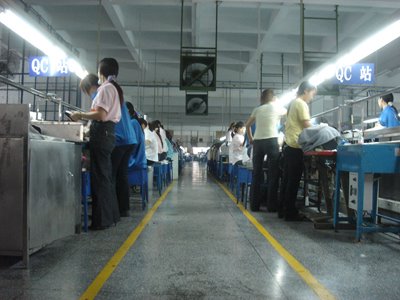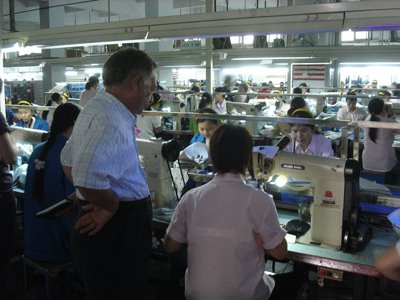
Of course no boot or shoe could be made (at least not yet) without stitching. During this phase of production, the various upper materials already prepared (printed, embossed, embroidered, etc.) come together in what is called a stitching line (a production line with stitching workers doing different parts/components), to tranform flat, single pieces into an (almost) whole shoe.
Click the Read More link below for more information.

During typical production, uppers are stitched and warehoused until ready for assembly. At the factory we use for our top boots however, a special production method, Lean Production, is used. In this type of production, similar to a JIT (Just In Time) production method, each step of production (cutting, stitching, lasting, assembly, etc.) is only completed when needed, usually on the same day. Thsi way, no unfinised goods are warehoused, making production time more efficient, consistent and better controlling quality.

This Lean Production, while it does have very many advantages, is also very difficult logistically to control, so it is usually only found in better, high quality factories. For complete Lean Production, all aspects from material suppliers to contracted printers, etc. must be very tighly coordinated to ensure everything is done at the right time.

In the stitching line, a number of workers will put the upper of the shoe together one part at a a time. Like a typical production line for cars, each person does just one part or task, to increase efficiency. One person may stitch the tongue together, another person will stitch the collar lining in, etc.

To help guide the stitching workers, lines are printed on the upper (as shown in the Cutting/Prep part of this series) to follow. Sometimes these lines are printed in a special ink that glows in UV lighting, as shown here.

Here you can see a worker using a hammer to hammer a reverse seam flat. When two parts are stitched together with the extra material on the inside, there is some bulk of this material. Hammering (either by hand or with a machine) helps flatted this bulk to avoid rubbing inside the shoe.



Here you can see an upper that is almost finished stitching. It is inside-out on the sewing machine, to stitch some of the last details in place. When almost complete the upper is a 3D shape, and open on the bottom, where the lasting/insole board will go.

After the uppers are completed, they are checked by QC, numbered and put into baskets to go upstairs to the next phase of production, lasting.

Materials
Cutting
Printing and HF embossing
Stitching
Lasting
Assembly
final QC and packing
Labels: case study, china, design, development, factory, football, hummel, leather, materials, process, production


2 Comments:
wiggidy ass wicket dood. its always good to hear what you have to say and teach. u in asia now, or back home? if ur asia now, can i ask u to make a shoe as in a super personal SMU?? hahahah... thad be tight.
im in denmark now, but going to asia in a week.
if you like these, check of the vintage pics in the following post.
keep it real, Z.
R
Post a Comment
<< Home